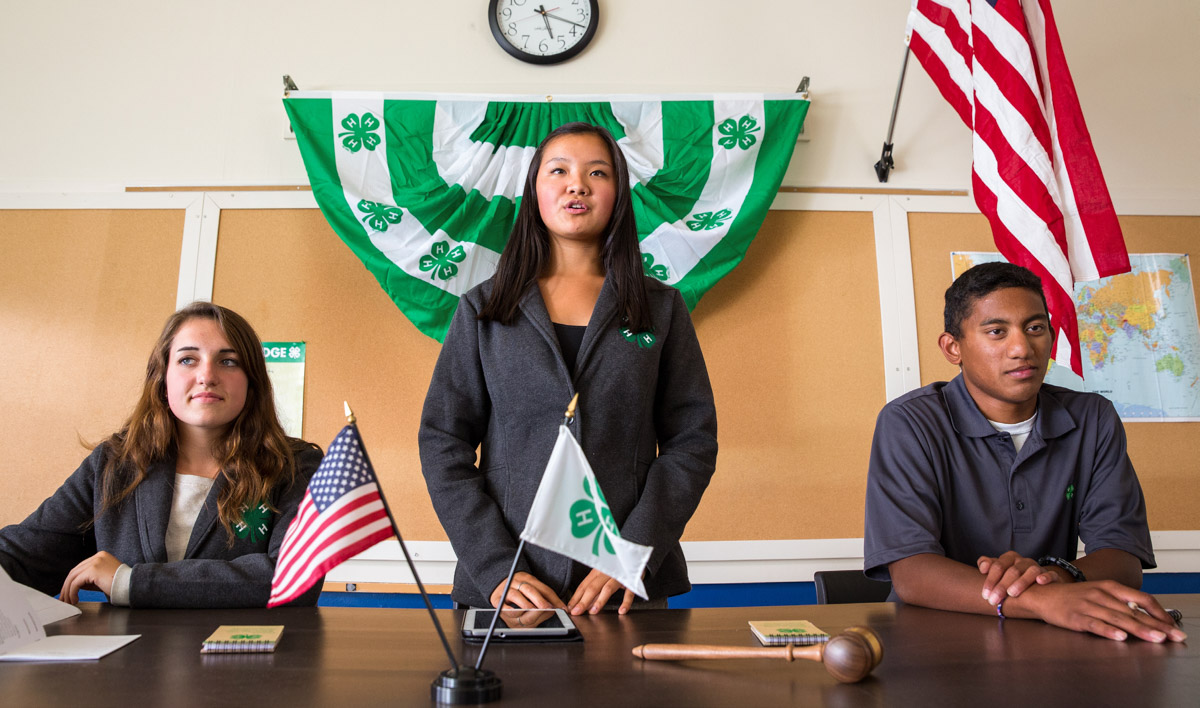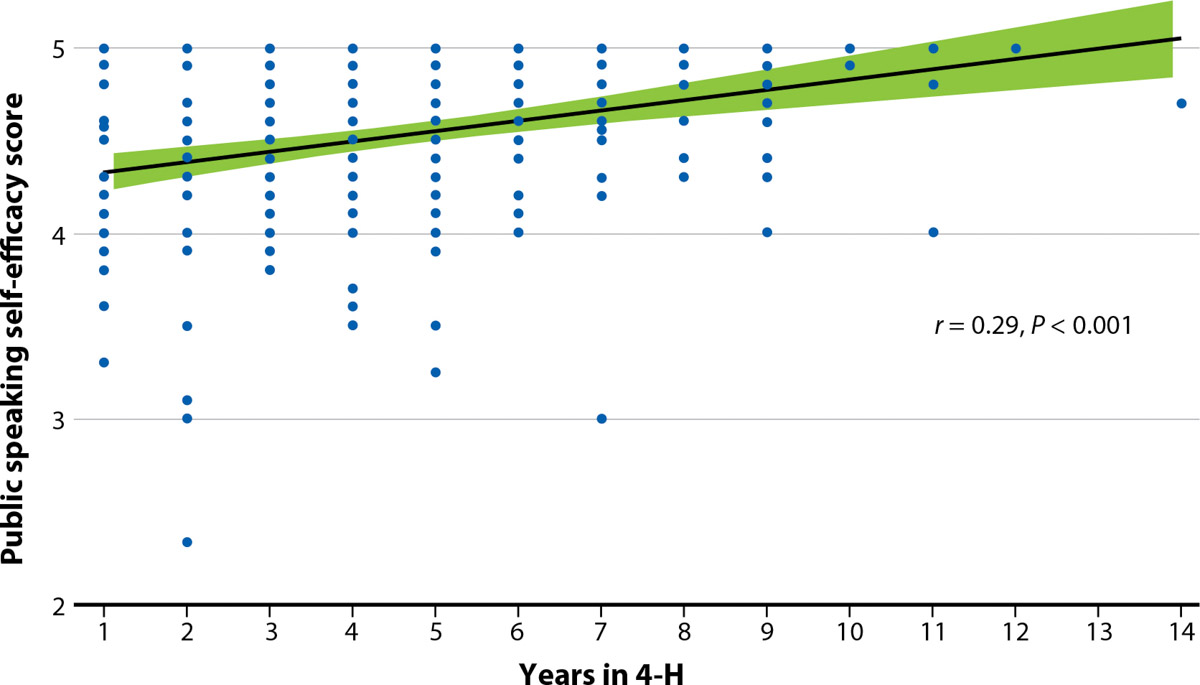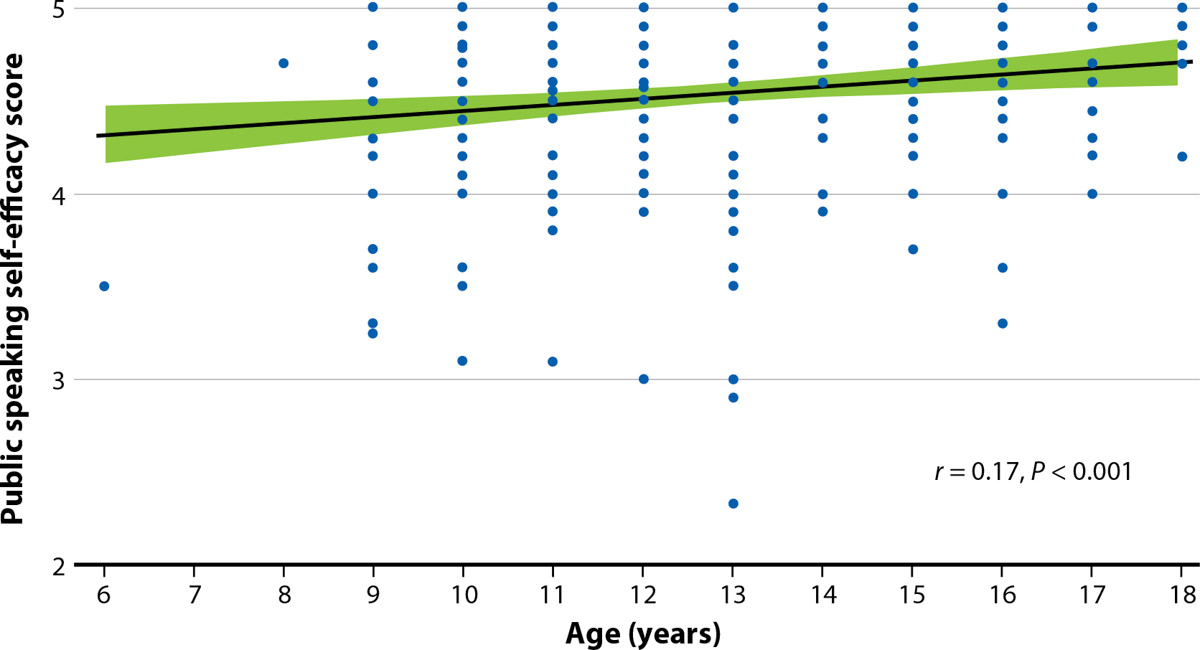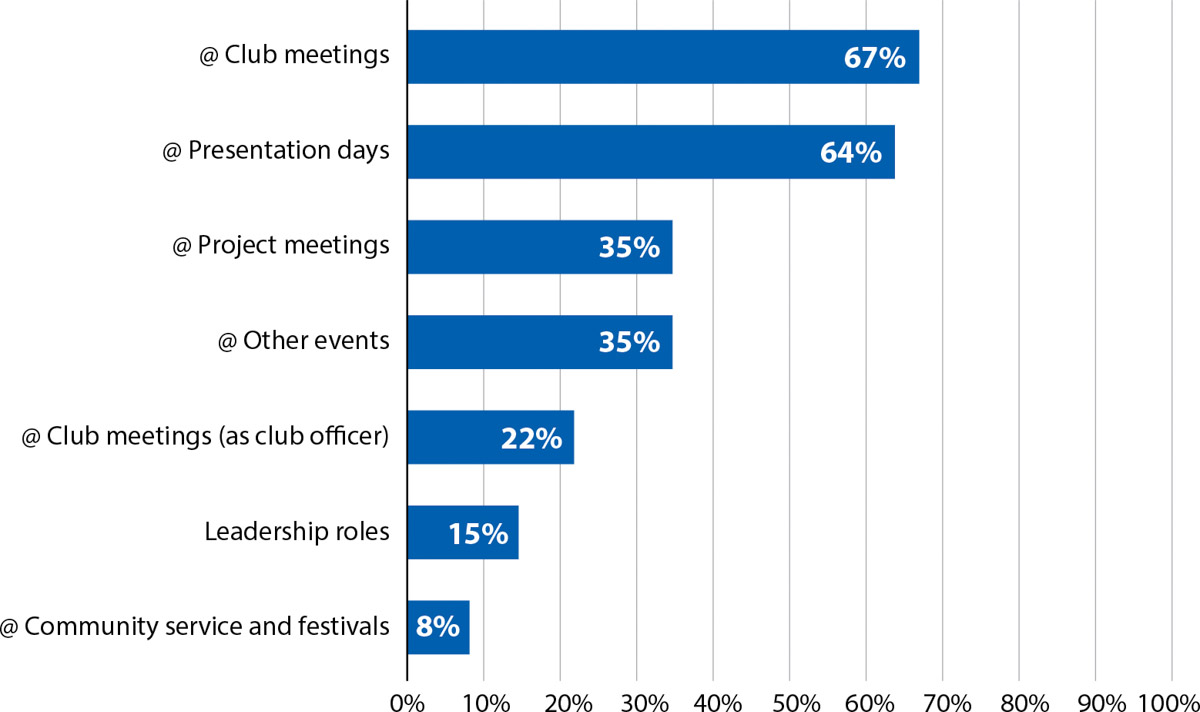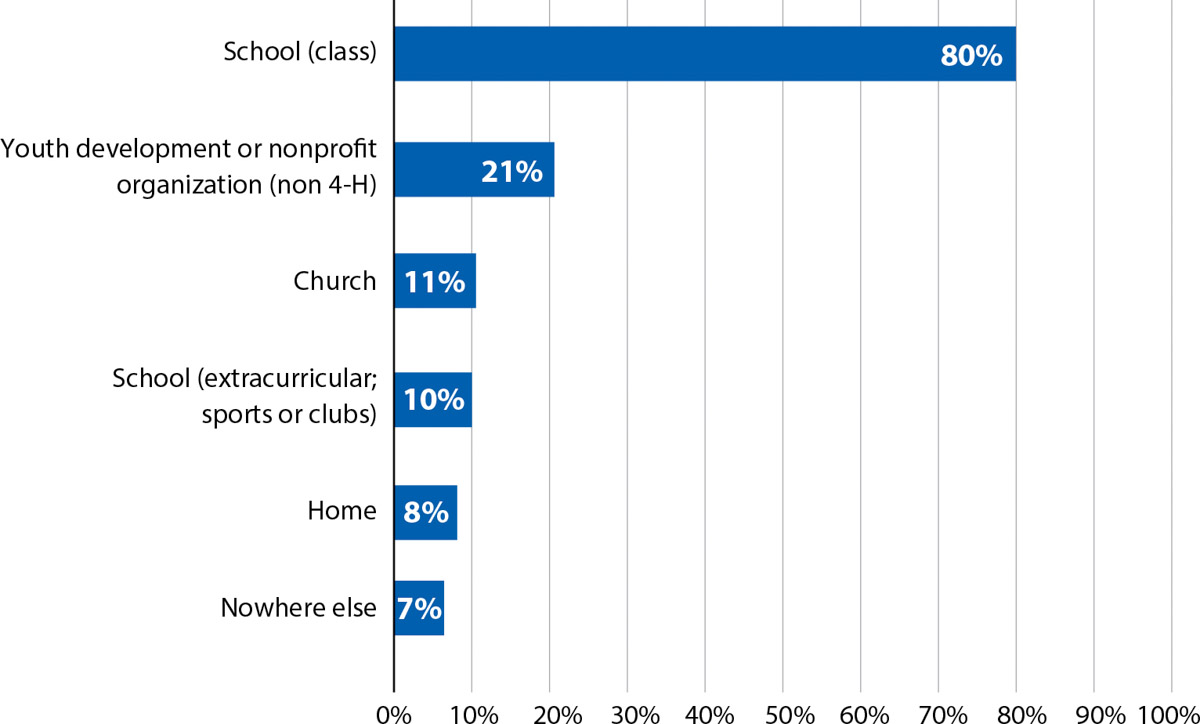All Issues
UC 4-H programs bolster youths' public speaking confidence
Publication Information
California Agriculture 77(1):30-35. https://doi.org/10.3733/ca.2023a0003
Published online April 24, 2023
PDF | Citation | Permissions
NALT Keywords
Abstract
Public speaking is an essential skill for the workforce, yet many professionals lack confidence when speaking in front of an audience. While the 4-H Youth Development Program helps young people learn and practice public speaking, little is known about which specific 4-H activities foster these skills. We conducted a study to explore 4-H members' public speaking confidence and to identify specific 4-H activities that bolster young people's public speaking confidence. Quantitative and qualitative survey analyses revealed that, regardless of age, the longer 4-H members spend in the program, the more their self-confidence in public speaking improves. The 4-H program offers unique opportunities for public speaking at club meetings and formal presentations. There is room to expand these opportunities by offering youth more instructional “how to present” materials and increasing low-stakes speaking venues.
Full text
The ability to communicate information in front of an audience is an essential skill in the workforce (Zekeri 2004). Professionals are expected to demonstrate strong communication skills and confidence when speaking in front of groups. However, most people dread public speaking. “Nearly 90% of people reported feeling shy or uncomfortable speaking in front of others at some time in their lives” (McCain 2012). Lack of confidence and fear of speaking to large audiences are some of the most common reasons for public speaking anxiety (Raja 2017). While practice can help alleviate anxiety, to become more confident over time, young people should begin developing their public speaking skills at an early age.
Young people may practice public speaking in their school classrooms, but these opportunities are usually few and far between. Also, these opportunities are often in groups, and can be full of tension due to high-stakes environments (Anderson 1997; Kellam 2018). There is a lack of published K-12 communication research and curriculum, and few educators are trained in communication. Those who teach communication education courses have few opportunities to learn best practices in their teaching credential program (Hunt et al. 2014).
Youth speak at a 4-H club meeting. The low-stakes environment is an essential component in helping boost young people's public speaking confidence. Photo: National 4-H Council.
Building confidence
While developing communication skills involves learning content, practicing skills, and improving attitudes, one of the most essential goals of any public speaking education program is to strengthen confidence itself. Building confidence is key, as a lack of confidence is the one of the most common reasons for anxiety in public speaking (McCain 2012). Confidence may be investigated using the concept of “self-efficacy,” defined by Bandura (1997) as the individual's belief in their skills and ability to perform, “the conviction that one can successfully execute the behavior required to produce outcomes” (Bandura 1997). We use the terms confidence and self-efficacy interchangeably, while acknowledging theoretical distinctions: “Confidence is a catchword rather than a construct embedded in a theoretical system” (Bandura 1997).
Public speaking self-efficacy can be described as the belief in an individual's own skill to successfully present a speech with effective content, structure and delivery (Tucker and McCarthy 2001). There are four primary sources hypothesized to influence self-efficacy (Bandura 1997; Bandura 2010): (a) mastery experiences (i.e., positive or negative public speaking experiences), (b) vicarious experiences (i.e., observing others give successful or inferior presentations), (c) social persuasion (i.e., positive or negative encouragement and feedback from peers and adults), and (d) affective state (i.e., psychological factors such as one's anxiety about public speaking). These sources of self-efficacy have remained prevalent in the scholarly literature since the inception of self-efficacy theory (Phan and Ngu 2016). Previous research has suggested that mastery experiences are the most impactful in influencing self-efficacy (Bandura 1997). Mastery experiences have the highest correlation with public speaking confidence, while the other three sources tend to have little to no influence (Warren 2011).
Mastery leads to confidence
Public speaking programs have been a cornerstone of the 4-H Youth Development Program since its inception (Wessel and Wessel 1982). Participation in 4-H public speaking events has immediate and long-term impacts, such as improved self-confidence, knowledge of subject matter, and life skills (Silliman 2009). Alumni of the 4-H program report that participation in 4-H was more helpful in developing their communication skills than participation in other youth organizations (Maas et.al. 2006; Radhakrishna and Doamekpor 2009).
The University of California 4-H Youth Development Program encourages 4-H members to give presentations in multiple venues: project meetings, club meetings, community projects, formal presentation days, and many others (Borba et al. 2019). Every 4-H member is encouraged to give a presentation in front of a live audience each year. There are multiple opportunities for youth to experience positive mastery experiences and build their public speaking self-efficacy. Annually, thousands of 4-H youth members participate in an organized event at the county, region (multi-county), and state level to present and receive feedback from a panel of three external raters (University of California 4-H Youth Development Program 2021; Worker et al. 2020; Worker et al. 2021).
While the outcomes of 4-H public speaking programs are acknowledged, there is a lack of empirical data exploring sources of self-efficacy and specific 4-H program activities that support youth in improving their public speaking. Our previous work (Marshall-Wheeler et al. 2022) showed that positive mastery experiences have the greatest correlation with high levels of public speaking self-efficacy. That is, successful presentation experiences were related to more positive self-efficacy beliefs, while negative experiences were related to lower self-efficacy beliefs (Tucker and McCarthy 2001; Warren 2011). Marshall-Wheeler et al. (2022) demonstrated that 4-H members report high levels of confidence in their public speaking abilities (mean = 4.6 on a 5-point scale), while successful presentation (mastery) experiences have the greatest relationship with public speaking confidence (ß = 0.435; P < 0.001; n = 125); we also found a positive (albeit small) positive correlation between public speaking self-efficacy and ratings given by external evaluators on the youth's 4-H presentations (ρ= 0.191; n = 126; P = 0.034). We advocated for more research to determine which mastery experiences influence public speaking self-efficacy. Identifying specific factors has the potential to inform program practice so that the most promising opportunities are leveraged to support youth in building their public speaking self-efficacy.
Surveying youth
The present study sought to explore relationships between 4-H membership and public speaking confidence, and to identify 4-H program activities members report as helping them improve their confidence.
Both 2020 and 2021 surveys included demographic information (age, years in 4-H, gender, race/ethnicity). The surveys also included a public speaking self-efficacy scale consisting of 10 items assessing speech content, structure, and delivery, with five items adapted from Warren (2011) and five items adapted from Karnes and Chauvin (2000). The 2021 survey included three open-ended questions asking youth where they practiced public speaking (in 4-H and other settings) and asked about specific 4-H public speaking experiences.
We conducted this study with youth who participated in the virtual 2020 and 2021 State 4-H Presentation Days and a 2021 County 4-H Presentation Day. We administered Qualtrics surveys sent via email to all participants. Out of 299 participants in the 2020 State 4-H Presentation Day, 176 responded to the public speaking self-efficacy questions in the post-event surveys, a response rate of 59%. For the 2021 State 4-H Presentation Day, 117 responded to public speaking self-efficacy questions, a response rate of 32%. For 2021, 47 youth responded to the survey at a 2021 County 4-H Presentation Day. The completed surveys were combined and checked for duplicate responses and missing data. If a youth had participated in multiple events, only their response to the 2021 State 4-H Presentation Day was considered for analysis. The combined dataset was composed of responses from 310 youth participants. Participants were 9 to 18 years of age, with an average age of 12.8 ± 2.5, and had been a 4-H member for a median of 5 years (mean = 4.8 with a standard deviation of 2.5). With regard to event participation, 61% of youth reported that this was their first time at either the 2020 or 2021 State 4-H Presentation Day. Nearly 67% identified as female, 32% as male, and 2% as preferring not to respond; 78% identified as White, 32% as Hispanic, 14% as Asian, 4% as American Indian or Alaskan Native, 2% as Black, and 2% as Native Hawaiian.
For the quantitative data, we computed Cronbach's alpha to calculate reliability (internal consistency) of the 10-item public speaking self-efficacy scale (α = 0.89). We created a composite variable using the mean of all items (missing data from items were dropped and the remainder of the items averaged). Using statistical software packages SPSS and R, we calculated correlations (Pearson's r), analysis of variance (ANOVA), and linear regression models (findings shared later in the manuscript), including scale reliability scores. We also standardized the public speaking self-efficacy composite variable as well as the five individual items from Warren (2011) using percent of maximum possible (POMP) (Fischer and Milfont 2010). POMP expresses scores in terms of the maximum possible score (e.g., 6 on Warren's 2011 survey and 5 on the present study's survey). Formula = ((Variable-Minimum Score)/ (Maximum Score-Minimum Score)) * 100.
The qualitative data was analyzed using an inductive thematic analysis (Braun and Clark 2006). First, two coders independently coded 40 longest-word county responses to the three questions, came to consensus on code application, and developed a code list. A decision was made to combine questions 1 and 2 because of similarity in code sheets. Coder 1 (first author) coded responses to the first two questions; Coder 2 (fourth author) coded responses to the third question. On the first two questions, there were 304 code applications on 124 responses (22 responses with one code application, 52 responses with two codes, and 50 responses with three or more codes). On the third question, there were 166 code applications on 122 responses (88 responses with one code application, 29 responses with two codes, and five responses with three or more codes applied).
Confidence grows over time
The number of years in 4-H was positively correlated with public speaking self-efficacy (Pearson's r = 0.29, n = 270, P < 0.001), indicating that the more years a young person participated in 4-H, the higher was public speaking self-efficacy on average (fig. 1). Additionally, age was positively correlated with public speaking self-efficacy (Pearson r = 0.17, n = 297, P = 0.003), indicating that older youth, on average, reported higher levels of public speaking self-efficacy (fig. 2).
A plausible hypothesis was that older youth were more confident due to their development and maturity rather than being influenced by participation in 4-H. To examine this, we computed three linear regression models with public speaking self-efficacy (dependent variable). Model 1: only years in 4-H (independent variable); Model 2: only age (independent variable); and Model 3: combined years in 4-H and age (using both as independent variables).
As separate models, age and years in 4-H were statistically significant (see table 1, Models 1 and 2). However, when combined into the same model, years in 4-H had the greatest effect (Standardized B) and was statistically significant, while age was not statistically significant (see table 1, Model 3). These results provided evidence for our claim that 4-H youth members report higher levels of public speaking self-efficacy the more years they have participated in 4-H, even when controlling for age.
Note that we also tested for, and did not find, a statistically significant difference in public speaking self-efficacy on gender or race/ethnicity.
Comparing to college students
We compared our findings to a study conducted by Warren (2011), who surveyed college students. The 4-H members in our sample reported higher scores when we compared findings for the entire scale and on the five individual items that were consistent between both studies. On average, 4-H members reported 89% public speaking self-efficacy compared to college students from Warren's (2011) sample reporting 75% public speaking self-efficacy. On individual item comparisons, 4-H members reported higher on all items than the college comparison sample. See table 2.
TABLE 2. Comparisons of public speaking self-efficacy between Warren (2011) college student sample and California 4-H member sample
Formal presentations
We asked youth where in 4-H they practiced public speaking and which 4-H experiences had helped them grow their public speaking skills. Through a qualitative analysis of their open-ended responses, we found that 67% reported public speaking at 4-H club meetings (e.g., project reports, committee reports, practice presentations), and 64% at formal 4-H presentation days (fig. 3). Only 35% reported practicing at 4-H project meetings or other events (e.g., countywide events, fairs, being a workshop facilitator). A lesser number, 22%, reported practicing at club meetings due to their officer role, and 15% in other leadership roles, such as being a county 4-H ambassador.
Besides school, young people do not have many opportunities to practice or grow their public speaking skills. Thus, 4-H is providing a valuable service focusing on public speaking.
When we asked youth where else they practiced public speaking besides 4-H, the overwhelming response — 80% of respondents — was at school (fig. 4). None of the other categories, as developed through qualitative analysis of the open-ended responses, came close. Only 21% of respondents reported the next highest category, which was other youth development or nonprofit organization.
Low-stakes opportunities needed
Our research suggests that the longer youth participate in 4-H and have opportunities to practice public speaking, the more confident they become. Presenting in front of real-life audiences increases confidence and public speaking skills (Marshall-Wheeler et al. 2022). While 4-H alumni consistently report 4-H helped them develop their public speaking skills (Radhakrishna and Doamekpor 2009), there has not been any published empirical literature exploring the contributing factors.
Our study revealed two primary program activities where youth say they are offered mastery experiences: 4-H club meetings and presentation days. This is not surprising considering these are the two recommended venues for public speaking in 4-H. What is interesting is that these two venues offer divergent mastery experiences. Club meetings are comprised of adults and young people who know each other, which lends a sense of familiarity and belonging. There are typically no awards or scored rubrics on performance. Club meetings are low-stakes environments where youth practice presenting in front of friendly audiences.
In contrast, presentation days are formalized events with several clubs and county programs where youth may not know each other. These events have panels of adult evaluators who use standardized rubrics to score and provide written feedback. Presentation days are higher-stakes venues, and youth — typically younger youth — may have some anxiety before presenting.
4-H County Ambassadors speak in front of a large crowd at the Marin County 4-H Achievement Day. Photo: Steven Worker.
We argue that both low-stakes, friendly venues (such as club meetings) and formal higher-stakes settings (presentation days) are needed to provide youth with a comprehensive set of mastery experiences. If young people present at only one or the other type of venue, it may not be enough to bolster their public speaking self-efficacy to the same degree. We acknowledge our explanation needs further testing, with data collected from youth who participate only in one venue or the other.
Given our findings, we offer several practical recommendations. First, 4-H professionals, in partnership with 4-H volunteer educators, should continue to host 4-H presentation days (at the county, regional, and state levels), while also providing low-stakes speaking opportunities at club meetings and other 4-H meetings. Professionals need to encourage 4-H club leaders to provide more speaking opportunities for members, especially for newer and/or younger youth. Second, there is a need for additional public speaking support materials (extension publications) to support youth and 4-H volunteers. Specifically, 4-H professionals need to design fact sheets and templates for 4-H youth on “how to present” that focus on content, structure and mechanics. Project and 4-H club leaders also need to offer more encouragement, support, and constructive feedback. We also need to investigate public speaking self-efficacy of all 4-H members, not only those who choose to participate in formal presentation days. It would also be helpful to conduct additional research to explore the differences in public speaking self-efficacy by race/ethnicity and gender.
One limitation to this study was that the regression models did not include several variables that could potentially help predict public speaking self-efficacy — for example, mastery skills and different types of 4-H public speaking experiences. Additionally, there was only a limited list of demographic variables for which the variation in public speaking self-efficacy was tested. The presence of additional variables in the regression model might change the effect of years in 4-H on the public speaking self-efficacy scores. Furthermore, the response rates were relatively low, given the number of youth who participated in either of the state 4-H presentation days. The response rate may have introduced systematic error into the results, perhaps biasing the resulting public speaking self-efficacy scores higher (or lower). We recommend repeating this study with larger groups of 4-H members.
In closing, numerous studies of 4-H alumni have demonstrated that 4-H strengthens both confidence and efficacy in public speaking, which are critical skills for succeeding in the workforce. The 4-H Youth Development Program plays a vital role in providing opportunities for young people to grow, practice, and improve their public speaking. It is important that 4-H professionals realize the important role they play in these successes and continue providing young people with the opportunities to expand their public speaking skills.



